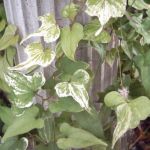| Common Name: |
Chinese Yam |
| Other Names: |
Cinnamon yam |
| Botanical Name: |
Dioscorea batatas syn. D. opposita |
| Genus: |
Dioscorea |
| Family: |
Dioscoreaceae |
| Native Location: |
China, Japan, Korea, Taiwan |
| Cultivation: |
Rich, well-drained soil in sun or partial shade. Tubers may rot in cool, damp conditions when dormant. |
| Propagation: |
By seed sown in spring at 19-24°C (66-75°F); by division or sections of tubers in autumn or early spring; by bulbils planted in spring. |
| Harvest: |
Tubers, roots, and rhizomes are lifted in autumn. Dioscorea batatas is used raw or baked with flour or soil, according to diagnosis, and D. villosa is dried for use in liquid extracts or used fresh for homeopathic preparations. |
| Height: |
3m (10ft) |
| Hardiness: |
Z5 |
| Parts Used: |
Tubers (shan yao) |
| Properties: |
A sweet, soothing herb that stimulates the stomach and spleen and has a tonic effect on the lungs and kidneys. |
| Medicinal Uses: |
Internally for poor appetite, chronic diarrhea, asthma, dry coughs, frequent or uncontrollable urination, excessive thirst, or sweating, diabetes, and emotional instability associated with qi deficiency. An ingredient of "The Pill of Eight Ingredients", a traditional Chinese remedy for diabetes, kidney problems, and under-active thyroid. Externally for boils and abscesses. |
| Culinary Uses: |
Tubers yield starch, known as Guiana arrowroot, and are eaten boiled, baked, mashed, or fried. Often combined in tonic soups with Lycium barbarum (See, Duke of Argyll's tea tree) and Polygonatum odoratum (See, angled Solomon's seal). |
| Bibliography: |
Encyclopedia of Herbs by Deni Brown Copyright © 1995, 2001 Dorling Kindersley Limited. Pg 194 |

